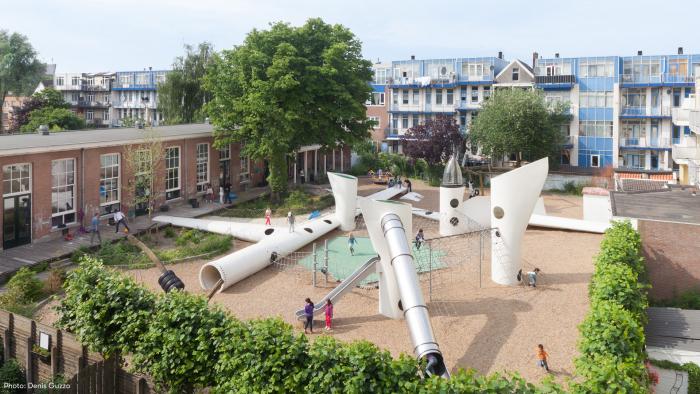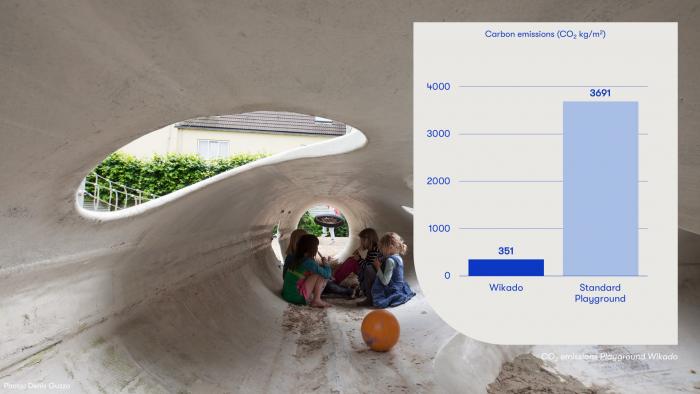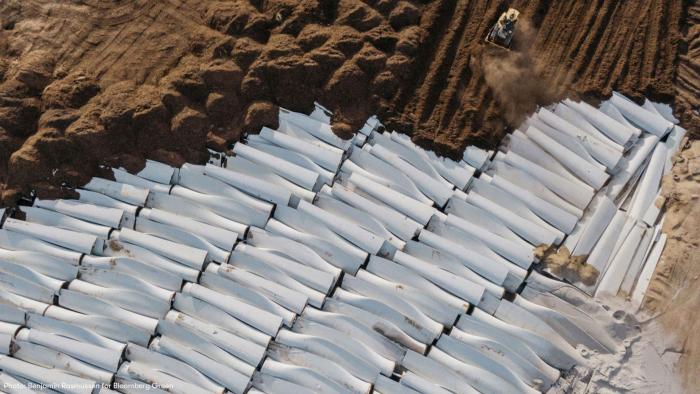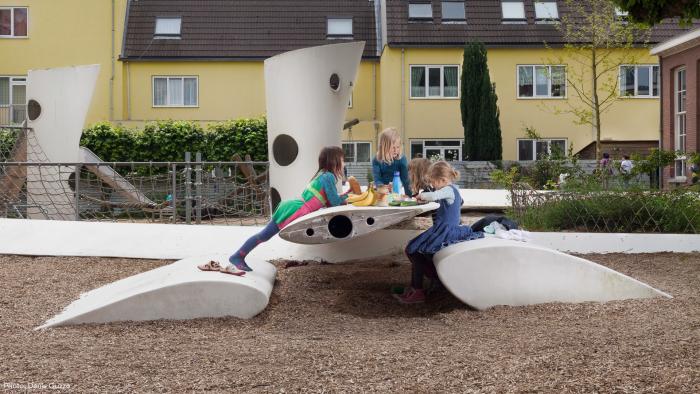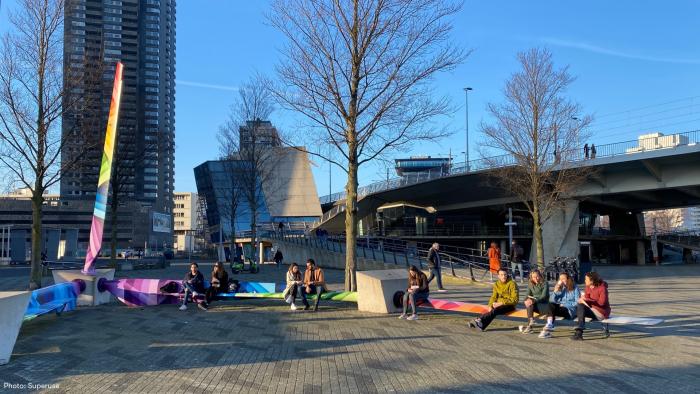I. SUMMARY INFORMATION
Project
269864
Status
Submitted
Award category
Techniques, materials and processes for construction and design
You want to submit
NEW EUROPEAN BAUHAUS AWARDS : existing completed examples
Project title
Blade Made Design Process by Superuse
Full project title
Blade Made Design Process for Playground Wikado in Rotterdam by Superuse
Description
Blade Made is a circular economy strategy by Superuse, where the waste of the wind energy sector is transformed into public furniture like seating, playgrounds or bus shelters. This specific example shows the first Blade Made project by Superuse, a playground in Rotterdam. By reusing the carbon emissions are reduced up to 90% compared to a standard playground. The striking aesthetic of Blade Made playgrounds stimulates the imagination of children and facilitates social interaction.
Where was your project implemented in the EU?
Netherlands
Zuid Holland
Meidoornstraat 47
51°56'07.8"N
4°29'02.8"E
Rotterdam
3036WC
When was your project implemented?
Has your project benefited from EU programmes or funds?
No
Which programme(s) or fund(s)? Provide the name of the programme(s)/fund(s), the strand/action line as relevant and the year.
II. DESCRIPTION OF THE PROJECT
Please provide a summary of your project
Superuse designed a new playground for a foundation called "Kinderparadijs Meidoorn" on their 1200m2 plot. The old playground was in a derelict state and in urgent need of renovation. Superuse mapped the old situation and carefully selected elements that were appropriate for reuse in the new playground. After this step the design was made. Our harvest of possible materials also yielded decommissioned rotor blades, which we investigated further.Five decommissioned rotor blades are placed around an existing concrete slab and they are used to create a maze-like space with a pentagonal panna (soccer) pitch in the middle. The base of the blades has been used as four towers, each with their own character. The cut off parts are spread around the garden and connect the towers. Between the towers a net provides an opportunity for climbing and is also preventing balls ending up in the backyards around the playground.Besides the rotor blades many components of the previous playground have been reused, for example the stainless steel slides and the tiles of the pavement. The tiles have been used vertically, reducing the total surface to transform the stoney playground into a wood chip ground cover that is better equipped for heavy rainfall. With reusing we are roughly reducing carbon emissions with 90% compared to a conventional playground.The abstract shape of the blades provides children with freedom to fantasize where and what they are playing. One time they might be pirates on a ship, on another day they are princesses in a castle or rabbits in a hole. There are over 90 pre-imagined ways to play in the installation, but so many have been added: letting children use their own imagination is one of the best things this playground has achieved.
Please give information about the key objectives of your project in terms of sustainability and how these have been met
Our client, Kinderparadijs Meidoorn, asked us to transform the existing worn down playground into a modern and sustainable space to play. The core objective was to give kids from this neighbourhood not just a place to play physically, but to play socially as well. We like to call this social sustainability, which means that the kids are encouraged to establish social skills that will also help them later in life. The organisation that runs the playground also provides art classes, cooking lessons, etc, but in the playground itself it's realised in a couple of ways. The pentagonal panna (soccer) pitch, made of shredded sneaker waste, in the middle shows that there is never a fair game of soccer, you always have to compromise and discuss how you are going to play. The same applies to the 'water tower', where one kid can use a pump to let others play with the water on a rotor blade. Kids are playfully forced to interact and cooperate with each other.To save the existing trees we've involved a specialist to help us make areas of preservation, providing plenty of space for the roots to grow. This environmental focus makes this playground a project of regeneration on a non-virgin soil. The monumental tree that was saved boosts the quality of the neighborhood, while the blades create a place of high interest.The reuse of waste flows is a core strategy in all our work, where this playground gave the opportunity to look at the waste provided by the renewable energy sector. The five blades have been cut in to pieces to remove the damaged parts. The parts have been rearranged to create a landscape for play. Normally a playground like this would have been made out of stainless steel, plastics and/or wood. By reusing the rotor blades we saved roughly 90% on carbon emissions compared to a regular playground, while it was built for the same price as a standard design playground.
Please give information about the key objectives of your project in terms of aesthetics and quality of experience beyond functionality and how these have been met
The aesthetic of using "urban mining materials" / "raw material" is a completely new topic in architecture. There is not much literature about the topic yet, especially when it comes to modern design interpretations. We (as architects) are in the middle of developing an innovative language and aesthetic, we are designing it, and the Blade Made playground Wikado is one of the first examples of this new language.The aerodynamic rotor blades turned out to be perfectly suitable for a playground that goes beyond the conventional. It brings a new aesthetic, since the shapes are not immediately recognizable, as is usually the case in playgrounds. Instead of providing something that resembles a ship or a castle, the Blade Made playground sparks the imagination of children and turns it into anything they want it to be. One day it is that traditional ship or castle, but the other day it might turn into a rabbits hole or become a spaceship instead.Since we discovered this source other Blade Made projects have been developed in The Netherlands. For a piece of urban furniture next to the Erasmus bridge we analyzed the aerodynamic shapes of 6m long blades, finding the perfect angle to create ergonomic seating. The blades are carefully crafted, a lot of money and energy has been invested to create high quality materials to harvest wind energy, it's a shame that these beautiful objects are discarded without prolonging their life as functional and durable objects in public space.
Please give information about the key objectives of your project in terms of inclusion and how these have been met
The playground is designed for children between 4 and 12 years old mainly, sometimes accompanied by their parents and at other times on their own. Kids are playfully stimulated to interact and cooperate with each other. People from Kinderparadijs Meidoorn are always around to see that the kids are safe and treat each other with dignity, with the aim of including everyone in what's happening.We tried to enhance this feeling of togetherness by removing physical barriers as much as possible, all the different spaces and area are designed as naturally flowing in to each other. The structure of blades and the veranda along the former school building help to create zones for different age groups. On the veranda there is a sheltered swing for toddlers, while the more rowdy playing with moving elements like swings is along the edges. The amount of opportunities for play is very high for the amount of square meters, which helps to create interesting and diverse playgrounds for children in big cities. We managed to create this high density of play by overlapping the perimeters that are set around playing equipments. The overlapping of these zones is achieved without compromising the safety of all children and carefully discussed with and checked by the certifying agent.The Blade Made furniture next to the Erasmus bridge was recently adopted by the LGBTQI+ community as a meeting point. They come together to celebrate, commemorate or activate, sitting on and around the blades. This resulted in a new paint job, showing a rainbow graphic designed by Mr June.
Please give information on the results/impacts achieved by your project in relation to the category you apply for
With the Blade Made Playground and other objects we have successfully shown that;Reuse of rotor blades is feasible and can be beautiful.New playgrounds can be made with a much smaller carbon impact (roughly 90% less) than conventional by reusing a material that would otherwise be landfilled or incinerated.Diversion of rotor blades is prolonging their lifespan and thus immediately reducing carbon emissions, while not preventing recycling in the future when this technology is available.Beside that it is interesting to note that;The Blade Made playground has been checked and certified by the Keurmerkinstituut, making it a safe playground.Blade Made playgrounds are flexible and modular. It can be re- designed in a completely different way in another location with other rotor blades. We have proven it once in Terneuzen with a playground on the beach, but it's possible anywhere.Costs are comparable to other designed playgrounds, with the possibility to reduce costs when scaling.The playground Wikado can be seen as the pilot project that led Superuse to discover the design potential of rotor blades and Superuse is now developing a family of urban furniture with reused rotor blades.Urban seating, signposting, a pedestrian bridge and bus shelters are extended designs from the Blade Made family that have already had similar impact to the playgrounds. It is a design language that can be spread to professionals throughout the EU and beyond, providing sustainability, inclusion, new aesthetics and a useful application of waste.
Please explain the way citizens benefiting from or affected by the project and civil society have been involved in the project and what has been the impact of this involvement on the project
The old playground was in need of renovation, but that didn't mean that the kids from the neighbourhood stopped coming. To help them with the mental process of letting the old playground go and accepting the new, we let the children be part of the transformation process. The last day of the old playground we dismantled parts together with the children, marking the end of that chapter. During the design phase we had already spoken with the kids about their wishes and needs, as well as to the neighbours living around the playground.All this input, along with observations how they used the old playground, led to the conclusion that the main activities in any playground are; chasing each other, hanging around, talking and using the swings and slides. Therefore we saved the old slides and even extended one and added mainly a structure to hang on, climb over, run through, etc.This structure is the Wikado, made from rotor blades, that not only is a landscape to play in and on. It is also creating different zones to distinguish places with high activity and movement and more quiet places to sit and talk. When the new playground opened for the kids, they all came running in and exploring their new favourite hangout. We come back every year or so to see how it is used and in the past decade it has been exciting to see new generations growing up around the Blade Made playground.
Please highlight the innovative character of the project
The decommissioning of the rotor blades is an emerging problem worldwide and the Blade Made strategy is an innovative experimentation to tackle that problem. In our rough estimates for the Netherlands alone we see an increasing flow of waste coming our way towards 2030, possibly around 1800 blades per year. When we addressed this problem for the first time a decade ago we looked at 200 blades per year. By inserting the rotor blade in a new design process their life span is extended and by staying true to their language of glass fibre reinforced polyester, we are not taking them out of a future recycling scheme.Rotor blades had never before been reused. Instead, most of the time they went and still go to landfill or incineration after they are decommissioned, since recycling was too expensive and underdeveloped. In the past years the recycling technique is improving, but still no real solution for the blades has been found. Since the first playground Wikado, we have made another playground, urban furniture and a bus stop out of rotor blades, getting to know the material as a really versatile and durable opportunity to create interesting urban spaces. To tackle the larger amounts we are also developing new concepts to extend the range of applications for these beautifully crafted blades, like a pedestrian bridge and sound barriers.
Please explain how the project led to results or learnings which could be transferred to other interested parties
One of the main learnings is that as a society we should become better in cascading materials, turning to repair and reuse before turning to recycling. This is true for all materials, but even more so when the recycling options are really energy consuming and the afterlife not completely clear. The blades have been used by Superuse on more occasions, since we've made the first Blade Made playground.Blade Made playground on the beach in Terneuzen, NLBlade Made seating in Rotterdam, also serving as a LGBTQI+ monument (image 6)Blade Made shelter in Almere next to a bus stationBlade Made art installation in GermanyBlade Made billboard for a thrift store in MaastrichtSince Superuse has shown the potential of blades, also other parties have been doing small scale projects.Art installation on a festival in the Netherlands by REFUNCArt installation in the Noordoost Polder by Elmo VermeijsBike shelter in Denmark
Is an evaluation report or any relevant independent evaluation source available?
III. UPLOAD PICTURES
IV. VALIDATION
By ticking this box, you declare that all the information provided in this form is factually correct, that the proposed project has not been proposed for the Awards more than once under the same category and that it has not been subject to any type of investigation, which could lead to a financial correction because of irregularities or fraud.
Yes
